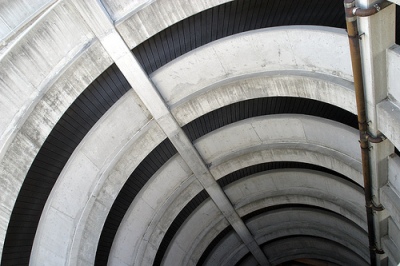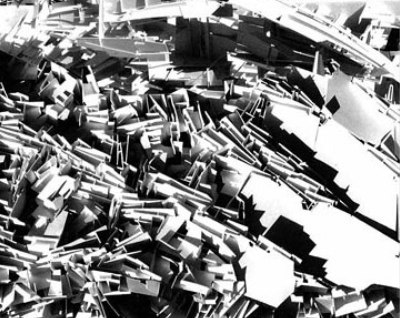In 1992 the Max Protech Gallery in New York had an exhibit of the concrete furniture work of Scott Burton. Chaise Longings, the catalogue of the exhibit, included an essay, “Concrete and Burton”, by Peter Schjeldahl (at the time an art critic for The Village Voice). It came to my attention when the following section was excerpted in Harper’s Magazine (published under the title, “Hard Truths about Concrete,” vol. 287, no. 1721, October 1993, pp. 28-30).
It is really more of a prose poem, or a paean to concrete than an essay of analysis or criticism. As an enthusiast of urbanism and the human built environment, I too have a considerable eros for concrete, and often find myself reciting lines from this passage to myself as I gaze out the train window rumbling about the city (usually the eastern branch of the red line).
1. Concrete
Concrete is the most careless, slovenly stuff — until it is committed, when it becomes fanatically adamant. Liquid rock, concrete is born under a sign of paradox and does not care. Pour concrete out on the ground and it will start to puddle and spread, in rapture to gravity, but then will think better of it: enough spreading! It heaps up on itself in lazy glops, sensual as a frog.
Concrete takes no notice of what is done with it, flowing into any container, and the containers one makes for it, the molds and forms, must be fashioned with laborious care, strong and tight, because concrete is heavy and entirely feckless. Promiscuous, doing what anyone wants if the person is strong enough to hold it, concrete is the slut, the gigolo, of materials. Every other material — wood, clay, metal, even plastic — has self-respect, a limit to what it will suffer to have done with it, and at the same time is responsive within that limit, supple in the ways it consents to be used. Concrete is stupid and will do anything for anyone, without protest or pleasure, so long as the person indulges its mania to lie down.
Let concrete set, however, and sense the difference. Concrete hardens in the shape of whatever container received its flow, its momentary sensual abandon in thoughtless submission to half-loved gravity. Once it has set, what a difference! Concrete becomes adamant, fanatical, a Puritan, a rock, Robespierre. It declares like no other material the inevitability, the immortality — the divinity! — of the shape it comprises, be the shape a glopped heap on the ground or a concert hall, ridiculous or sublime.
Concrete that has set will have no thought, no monomaniacal obsession until the end of time, except this shape. No other material — not brick, not wood, not the very stone blocks of the Great Pyramids forgets itself to such an extent. Bricks planks of wood, and stone blocks whisper from their built configurations of their willingness to be disassembled and to become something else. Whorish but ironic plastic holds back from a lasting passion for the form it takes, murmuring of its readiness if given heat, just some lovely heat, to melt into other forms. Likewise metal and glass. Not concrete once concrete has set.
Set concrete insists, insists, insists. It insists on the rightness, permanence, godliness of the form into which it flowed so carelessly. You must smash set concrete to bits if you would shut up the voice of its insistence, and even then the smashed bits will lie around insistently piping. I was in Berlin early in 1990 and remember a thousand hammers banging away at the Wall, banging out “die, die, die!” The concrete of the awful thing was shrieking back “wall, wall, wall!” It took a long time for the hammers to win the argument, and even then the shattered corpse would not give in. I brought a handful of fragments home, and the ones that retained any flat surface still shrill “wall” in tiny voices, totalitarian for eternity.
There is something inappropriate, not quite right, about the notion of “working” concrete, finely finishing it, making its forms true, smooth, and pristine. It seems insulting to concrete’s gross strength and simplemindedness, mocking concrete as one might a rough farmworker by forcing fancy evening dress on him. Unlike the farmworker, however, concrete is unmockable because it is impervious. Go ahead and make fun of concrete. You might as well. Concrete will never notice.
Concrete has no feelings to hurt. It does have feelings, as we know, but they are adamantine, fanatic, and untouchable by anything. Concrete is solipsistic. By contrast, clay is touchy, wood is as woundable as the flesh it is, and brick has a yeoman worker’s pride, stolid and prickly. All have good reason to fear misuse and to exude sadness when misused. But kick concrete as much as you like, all you will hurt is your toe.
Concrete is among the world’s best exercise devices for unrequited loving. You may love and serve it until your heart is worn out and be assured of no responsiveness, not a quiver in return. No loathing, even. Nothing! Concrete is like Don Quixote’s Dulcinea, only colder. Coarse and stupid beyond compare, it combines these qualities with the froideur of a goddess, of Pallas Athena! It is a dominatrix, blind, deaf, and dumb, dumb beyond anything. You have to be a masochist to love concrete, enjoying the strength that your own capacity to love displays when the loved one is a pitiless idiot.
I too have a piece of the Berlin Wall, brought back for me by a friend who was visiting at the time. One side was part of the flat exterior of the wall. On the other side, two inches into the wall from the face, is an impression left by the concrete’s envelopment of a shaft of rebar.
Photographs “Aluminum Concrete Forms in Hong Kong” and “High Rise Concrete Construction In Venezuela” courtesy of Wall-Ties & Forms, Inc.; “Abbott Hospital Parking Garage Ramp, Minneapolis, MN” courtesy of Zachary Korb; used under the Creative Commons Attribution-Noncommercial-Share Alike 2.0 Generic license.





